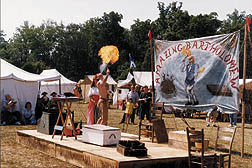

Department of Environment and Conservation
A Touch of the 18th Century
By James Brannon
Photos by John Froeschauer
 In September, as the summer heat slowly begins to give way to the
coolness of fall, a small piece of the 18th century returns to East Tennessee.
In September, as the summer heat slowly begins to give way to the
coolness of fall, a small piece of the 18th century returns to East Tennessee.
There, in the shadow of the Great Smoky Mountains on the banks of the Little Tennessee River, Fort Loudoun State Historic Area in Vonore will host its fourth annual 18th Century Trade Faire, September 12-13.
"Trade Faires" were common sights throughout the 18th century, both in England and in most American colonies.
In the early days of the century, these trade fairs were mainly commercial. In England, important fairs were held in London, Bristol, Oxford, Bath and in many other towns.
One early trade fair was known as St. Bartholomew’s Faire. This fair started mainly as a cloth fair with merchants exhibiting their cloth in the town Priory.
This fair, like other English fairs, grew into a more generalized market fair as the century progressed. Streets were filled with booths exhibiting lace, metal wares, jewelry, toys and secondhand cloths, just about anything could be found for sale.
Entertainment was part of the "Trade Faire." There were booths filled with wild beasts, freaks and dwarfs. Quack doctors set up shop. Puppet shows, conjurers and theatrical plays were presented. One famous entertainer known as Faux had became so celebrated that at his death he was worth 10,000 British pounds. In 1769, St. Bartholomew’s Faire grew to such a point that the mayor had to appoint 72 special constables. Violence, robbery and even an occasional murder had also become part of the event.
In America, annual Colonial trade fairs were a part of the lives of people in most of the English colonies, everywhere except in New England, where they occurred only occasionally.
In Connecticut, trade fairs were not allowed at all. Samuel Peters, of Connecticut, said that dancing, hunting, fishing, skating, and sleighing on the ice were the only acceptable forms of entertainment.
The colonial versions of the trade fairs were usually ordained by law, but sometimes support came through private fundraising as exemplified by the Rye New Hampshire Trade Faire and by the Williamsburg Faire in 1739.
Horses, oxen, sheep, cloth, jewelry, foods, and all types of sundry items were seen at
these fairs. Entertainment and sports were popular. At the Williamsburg Faire, foot races
from the college to the capitol were popular. On Long Island, a race for women was watched
with great excitement. There were cudgeling bouts (in which contestants fought with
sticks), a greased pig contest and a grinning contest. Puppet shows, ropewalking and
fortune tellers were all popular at the fairs. In Virginia, these fairs were also used as
occasions to pay debts, trade horses and obtain bills of exchange.
Throughout the 18th century, trade fairs played an important role in the lives of the people. People from all walks of life and all class levels could be seen attending. Farmers, merchants, tradesmen, entertainers, mountebanks, pickpockets and thieves all came to the fair. Even though these fairs began to serve the merchants, they soon outgrew this limited role and came to fill the social needs of many people of the 18th century.
Each year for the past three years, Fort Loudoun State Historic Area has tried to recreate this mainstay of 18th century life. In 1997, there were nearly 200 reenactors and almost 5,000 visitors. These visitors watched in awe as the Amazing Bartholomew breathed fire and did magic.
They enjoyed the puppet shows and music of Common Stock and the traditional Celtic music of the Celtic Jammers. Visitors strolled down the rows of tents, listening to the call of the trader and sometimes stopping to buy a token of the 18th century.
This year’s 18th Century Trade Faire will be held September 12-13 from 10 a.m. to 5 p.m. at Fort Loudoun State Historic Area. Fort Loudoun is located about 30 miles south of Knoxville off Highway 411, in the town of Vonore.
For more information, call the park office at 423/884-6217 or write to: Fort Loudoun State Historic Area, 338 Fort Loudoun Rd., Vonore, TN. 37885.
(James Brannon is park interpretive specialist at Fort Loudoun State Historic Area.)
Updated July 1, 1998; Send comments to Department of Environment and Conservation.